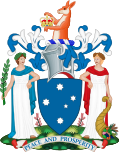Lutheran Trinity Church, East Melbourne
1874 establishments in AustraliaChurches completed in 1874Churches in MelbourneHarv and Sfn no-target errorsHeritage-listed buildings in Melbourne ... and 2 more
Lutheran churches in AustraliaUse Australian English from March 2019

The Lutheran Trinity Church in East Melbourne, Australia, is a Lutheran heritage-listed church. It was built in 1874 and was added to the Victorian Heritage Register on 9 October 1974. The church is on Parliament Place, immediately to the south of St Patrick's Cathedral and east of Parliament House. Most church services are in German.
Excerpt from the Wikipedia article Lutheran Trinity Church, East Melbourne (License: CC BY-SA 3.0, Authors, Images).Lutheran Trinity Church, East Melbourne
Parliament Place, Melbourne East Melbourne
Geographical coordinates (GPS) Address Nearby Places Show on map
Geographical coordinates (GPS)
| Latitude | Longitude |
|---|---|
| N -37.810972222222 ° | E 144.97577777778 ° |
Address
German Lutheran Trinity Church
Parliament Place 22
3002 Melbourne, East Melbourne
Victoria, Australia
Open on Google Maps








